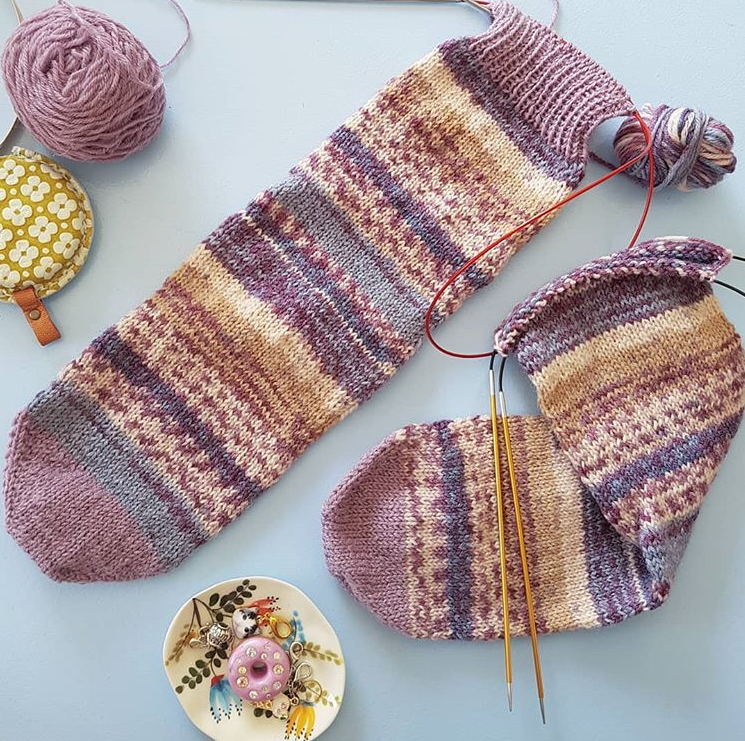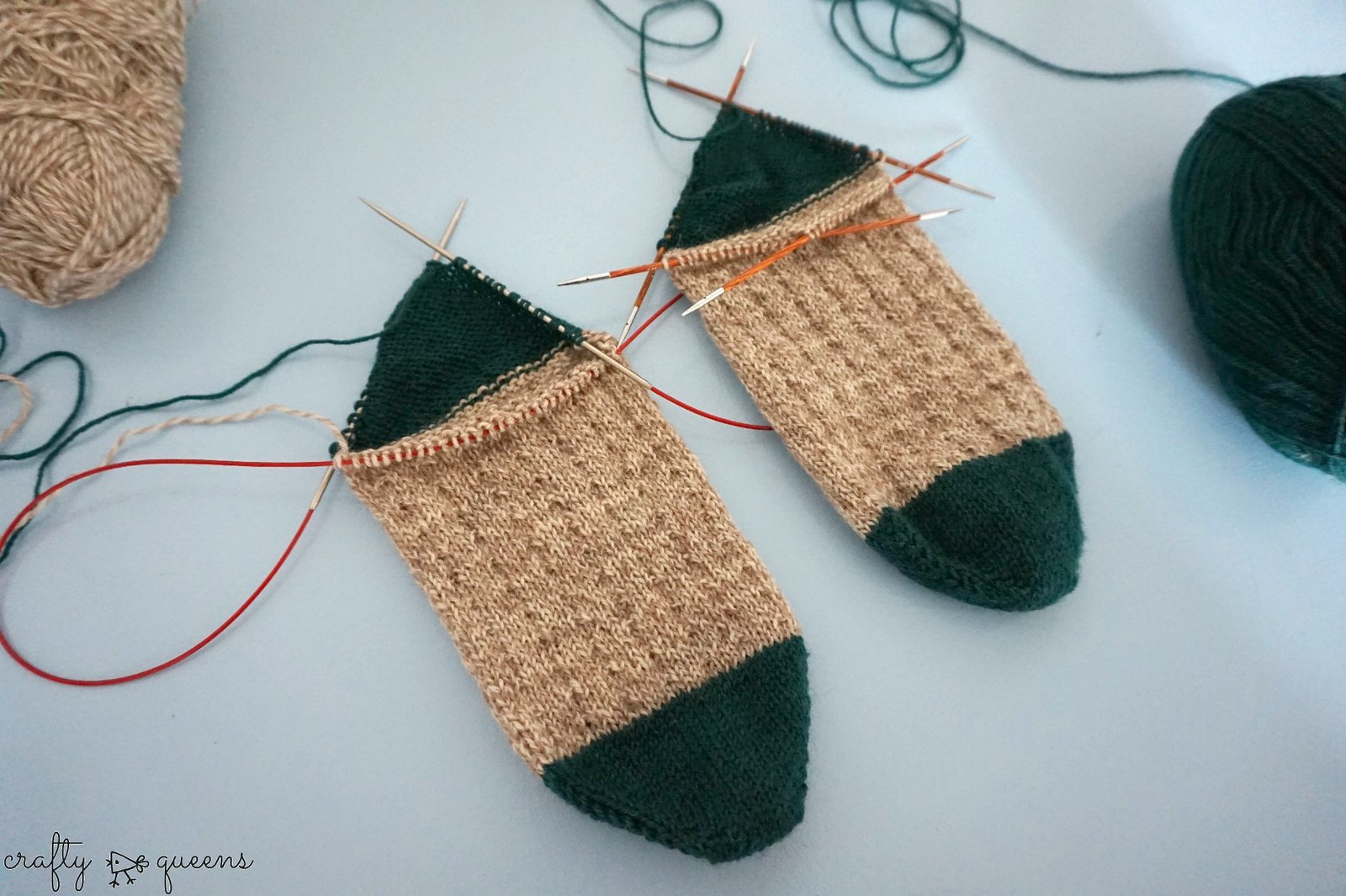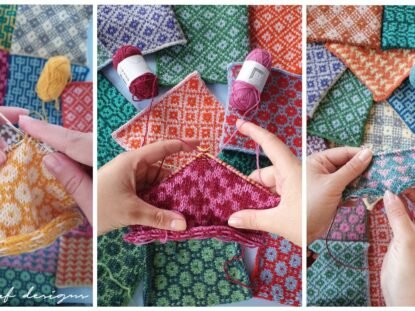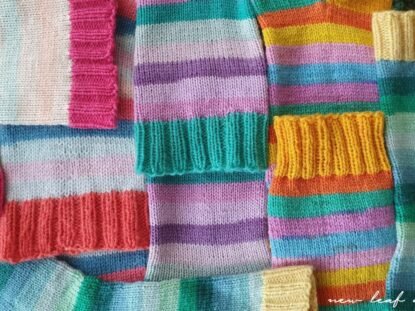Sock yarn | Sokkengaren
Sock yarn comes in all shapes and sizes, but which one will work best for you? In this blogpost I’ll explain what to look for, so you can get more enjoyment out of knitting and wearing your socks.
Sokkengaren is er in alle vormen en maten, maar welke werkt nou het best? In dit artikel leg ik je uit waar je op moet letten, zodat jij meer plezier hebt in het breien én dragen van je sokken.
Only for socks? | Alleen voor sokken?
Sock yarn is most definitely not just for socks. Usually what the manufacturers mean by labeling it as ‘sock yarn’, is that it is durable enough for socks. I’ll get into this more when discussing the fibre content below. You can use sock yarn to knit or crochet almost anything, whether it’s shawls, sweaters, toys, cushions, rugs, bags, you name it. After all, who wouldn’t like a sweater that can last for ages? Since socks are still the most popular thing to knit, yarn manufacturers label the yarn as ‘sock yarn’ so that it is immediately clear that this yarn can be used to create socks.
Sock yarn has a bit of a reputation of not being soft, but that is not always true! It depends on the fibre content, typically if you see ‘merino’ on the label it will be softer than if it just says ‘wool’. Nowadays most produced sock yarns are soft enough to use for shawls and garments.
Sokkengaren is zeker niet alleen maar om sokken mee te maken. Meestal wilt de fabrikant het duidelijk maken dat het garen zelfs stevig genoeg is om sokken van te maken, hierover vertel ik later nog wat meer. Je kunt in principe sokkengaren voor alles gebruiken: sjaals, truien, knuffels, kussens, vloerkleden, tassen, en nog veel meer. Wie wilt er nou niet een trui die jarenlang meegaat? Omdat sokken nog steeds het populairst zijn om te maken, kiezen fabrikanten ervoor om het te labelen als sokkengaren zodat het direct te herkennen is.
Aan de term sokkengaren kleeft een imago dat het niet zacht is, maar dat is zeker niet altijd waar. Het hangt natuurlijk van de samenstelling af, als er op het label ‘merino’ staat zal dat meestal een zachter sokkengaren zijn dan als er gewoon ‘wol’ op staat. De meeste sokkengarens die tegenwoordig geproduceerd worden zijn ook zacht genoeg om sjaals en truien mee te maken.

What is sock yarn made of? | Waar is sokkengaren van gemaakt?
A typical sock yarn you find nowadays is made up of 75% wool, and 25% nylon. Instead of wool, you might also find a specific type of wool such as ‘merino’ or ‘blue faced leicester’ on the label. Different types of wool will have different qualities. Instead of nylon, you may also see ‘polyamid’. These two words are often used interchangeably and there is not much difference between them.
You will find on the label if the yarn can also be washed in the washing machine, or only by hand. Usually sock yarns are made to withstand machine washing. Another reason to try sock yarn for knitting or crocheting a sweater!
Aside from the fibre content, one thing I also find very important is how the yarn is plied. The plying of a yarn refers to whether it’s made up out of one strand (single ply) or made up out of several thinner strands plied together. Most sock yarns consist of four plies (4-ply). What is the difference? The more plies a yarn has, the more durable it is. Single ply yarn is not suitable for socks, so look for a yarn with more plies if you want to knit socks.
Een typisch sokkengaren is bestaat uit 75% wol en 25% nylon. In plaats van wol kun je ook een specifiek type wol zien staan zoals ‘merino’ of ‘bluefaced leicester’. Elke soort wol heeft weer specifieke eigenschappen. In plaats van nylon staat er soms ‘polyamide’, er is niet veel verschil tussen de twee.
Op het etiket vind je ook of het garen in de wasmachine gewassen mag worden, of alleen op de hand. Normaliter kunnen sokkengarens in de wasmachine worden gewassen, nog een reden om truien ook van sokkengaren te maken!
Naast de samenstelling vind ik één ander ding nog heel belangrijk en dat is hoe het garen getwijnd is. Als het garen uit één draad bestaat is het ongetwijnd. Als je het garen kunt splitsen in dunnere draadjes, is het juist wel getwijnd. Bij sokkengaren zul je het vaakst zien dat het bestaat uit 4 draden. Wat is het verschil? Hoe meer draadjes, hoe sterker het garen. Ongetwijnd garen is daarom niet geschikt voor sokken, dus zoek een garen dat wel getwijnd is.

Commercially or handdyed? | Commercieel of handgeverfd?
There are so many different types and brands of sock yarn out there, it’s easy to get overwhelmed. Alongside the commercial brands for sock yarn, there are lots of handdyers offering sock yarn as well. What is the difference, and what should you look for? When looking at a commercial yarn and a handdyed yarn objectively, the first thing you notice is the price. A handdyed yarn costs more than a commercially dyed one, even though both prices are fair. Handdyers have a smaller market, the dyeing process is more labour intensive, and their materials are more expensive to purchase. Commercial yarnbrands have a bigger marker, the dyeing process is made easier and quicker by using machinery, and they often have a better deal obtaining the raw product. Okay, so that justifies the price, but what is the actual difference for you as the maker? Handdyers often give much more attention to their product, producing colours in a way that machines aren’t able to, and give you a truly unique yarn. Commercial yarn may have knots in it, whereas usually handdyed yarns do not. Often you will also find lesser known sheep breeds in handdyed wool, and some handdyers even use local wool!
Er zijn zoveel verschillende types en merken van sokkengaren, dat je bijna door de bomen het bos niet meer ziet. Naast de commerciële merken zijn er nu ook handververs die sokkengaren aanbieden. Wat is het verschil, en waar moet je naar kijken? Wanneer je een commercieel garen en handgeverfd garen vergelijkt, valt je wellicht eerst de prijs op. Een handgeverfd garen kost meer dan een commercieel geverfd garen, en beide prijzen zijn fair. Handververs hebben een kleinere afzetmarkt, het verfproces is intensiever, en de materialen verkrijgen ze meestal tegen een hogere inkoopprijs. Commerciële garenfabrikanten hebben een grotere afzetmarkt, het verfproces wordt gemakkelijker en sneller gemaakt door gebruik van machines, en ze hebben meestal een betere deal voor de materialen. Dat verklaart de prijs, maar wat betekent het nu eigenlijk voor jou als maker? Handververs geven vaak extra aandacht aan hun garens en kleuren het op een manier dat machines nog niet kunnen namaken. Zo krijg je echt een uniek garen. Commercieel garen heeft soms knoopjes, en bij handgeverfd garen zie je dit minder. Vaak kunnen handververs ook wol gebruiken van minder bekende schapenrassen, en soms gebruiken ze zelfs lokale wol!

And now.. cast on! | En nu.. opzetten!
Now you know more about sock yarns and the different things you can look for, it’s time to cast on! Do you know my pattern Simple Toe Up Socks? It’s my favourite sock pattern, perfect for beginners, and contains lots of video links to help you understand the pattern.
Nu je meer weet over sokkengarens en waar je op moet letten, is het tijd om op te zetten! Ken je mijn patroon Simple Toe Up Socks al? Het is mijn favoriete sokkenpatroon, ook geschreven in het Nederlands, en bevat tutorial video’s om je op weg te helpen.








No Comment